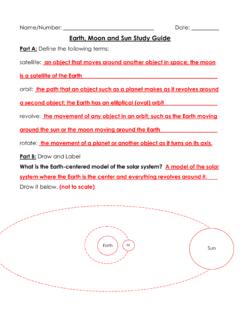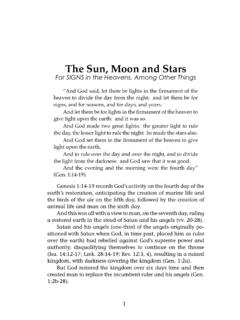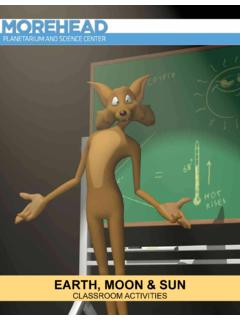Transcription of Exploring Earth, Sun, and - GVLIBRARIES.ORG
1 'sGuideExploringEarth,Sun, :LouiseMarrierGraphics:FredThodalHeidiBe rryDeanLadagoBrianBlivenEmilyMerkertLynd seyCanfieldPage21-800-453-8481 VisualLearningCompanyExploring earth , Sun, and MoonThe purchase of this video program entitles the user the right to reproduce or duplicate, in whole or in part, this teacher s guide and the black line master handouts for the purpose of teaching in conjunction with this video, Exploring earth , Sun, and moon . The right is restricted only for use with this video program. Any reproduction or duplication, in whole or in part, of this guide and student masters for any purpose other than for use with this video program is video and accompanying teacher s guide are for instructional use only.
2 In showing these programs, no admission charges are to be incurred. The programs are to be utilized in face-to-face classroom instructional settings, library settings, or similar instructional Rights are available, but must be negotiated with the Visual Learning , cable, or satellite rights are also available, but must be negotiated with the Visual Learning circuit rights are available, and are defi ned as the use of the program beyond a single classroom but within a single campus. Institutions wishing to utilize the program in multiple campuses must purchase the multiple campus version of the program, available at a slightly higher may be granted to institutions interested in purchasing programs in large quantities.
3 These discounts may be negotiated with the Visual Learning video and this teacher s guide are the exclusive property of the copyright holder. Copying, transmitting, or reproducing in any form, or by any means, without prior written permission from the copyright holder is prohibited (Title 17, Code Sections 501 and 506).Copyright 2006 ISBN 19781592341566A Message from our Company ..Visual Learning is a Vermont-based, family-owned company specializing in the creation of science programs. As former classroom science teachers we have designed our programs to meet the needs and interests of both students and teachers.
4 Our mission is to help educators and students meet educational goals while experiencing the thrill of science!Viewing ClearancesUse and Copyright:Page31-800-453-8481 VisualLearningCompanyExploring earth , Sun, and MoonTableofContents222456778121314161819 20212224A Message from our CompanyViewing ClearancesUse and CopyrightNational Standards CorrelationsStudent Learning ObjectivesAssessmentIntroducing the ProgramProgram Viewing SuggestionsVideo ScriptAnswer Key to Student AssessmentsAnswer Key to Student ActivitiesPre-TestPost-TestVideo ReviewVocabularyWriting ActivityMission to the moonShadows in SpacePhases of The MoonPage41-800-453-8481 VisualLearningCompanyExploring earth , Sun, and MoonEarth and Space Science - Content Standard D.
5 National Standards CorrelationsBenchmarks for Science Literacy(Project 2061 - AAAS), Grades 3-5By the end of the fi fth grade, students should know that:National Science Education Standards(Content Standards: K-4, National Academy of Sciences)The Universe (4A): Things on or near the earth are pulled toward it by the earth s gravity. Like all planets and stars, the earth is approximately spherical in shape. The rotation of the earth on its axis every 24 hours produces the night-and-day cycle. To people on earth , this turning of the planet makes it seem as though the sun, moon , planets, and stars are orbiting the earth once a day.
6 As a result of their activities in grades K-4, all students should develop an understanding of: Objects in the sky have patterns of movement. The sun, for example, appears to move across the sky in the same way every day, but its path changes slowly over the seasons. The moon moves across the sky on a daily basis much like the sun. The observable shape of the moon changes from day to day in a cycle that lasts about a month. Page51-800-453-8481 VisualLearningCompanyExploring earth , Sun, and moon Cite some of the characteristics of earth which make it unique in our solar system, including: earth s moderate temperature, the abundance of liquid water, and the presence of oxygen in the atmosphere.
7 Defi ne gravity as the force of attraction between two objects in space. Also, state that gravity is the force which pulls objects toward the center of earth . Understand that the force of gravity holds earth and the other planets in orbit around the sun. State the importance of the sun, and the fact that life as we know it depends on the sun. Explain that the sun is made up of very hot gases with temperatures in the millions of degrees. State some of the characteristics of the moon including the fact that it is about 1 4 the size of earth s diameter, has a dusty surface with plains and mountains, and has great temperature fl uctuations.
8 Understand that the moon does not generate its own light, but instead refl ects light from the sun to earth . Explain why the moon appears to have different shapes throughout the course of the month. Identify the following phases of the moon : new moon , fi rst quarter, full moon , and third quarter. Differentiate between the processes of waxing and waning. Create separate diagrams of a lunar eclipse and a solar eclipse. In each diagram label the sun, earth , moon , and shadow. Explain that tides involve the regular rise and fall of ocean levels about every 121 2 hours.
9 Understand that the gravitational interaction of the moon and earth is responsible for the Learning ObjectivesUpon viewing the video and completing the enclosed student activities, students will be able to do the following:Page61-800-453-8481 VisualLearningCompanyExploring earth , Sun, and MoonThe Post-Test can be utilized as an assessment tool following student completion of the program and student activities. The results of the Post-Test can be compared against the results of the Preliminary Test to assess student (p. 16-17):The Video Review can be used as an assessment tool or as a student activity.
10 There are two sections. The fi rst part contains questions displayed during the program. The second part consists of a fi ve question video quiz to be answered at the end of the Review (p. 18):The Preliminary Test is an assessment tool designed to gain an understanding of students preexisting knowledge. It can also be used as a benchmark upon which to assess student progress based on the objectives stated on the previous Test (p. 14-15):AssessmentPage71-800-453-8481 VisualLearningCompanyExploring earth , Sun, and MoonIntroducing the ProgramProgram Viewing SuggestionsThe student master Video Review is provided (p.)










